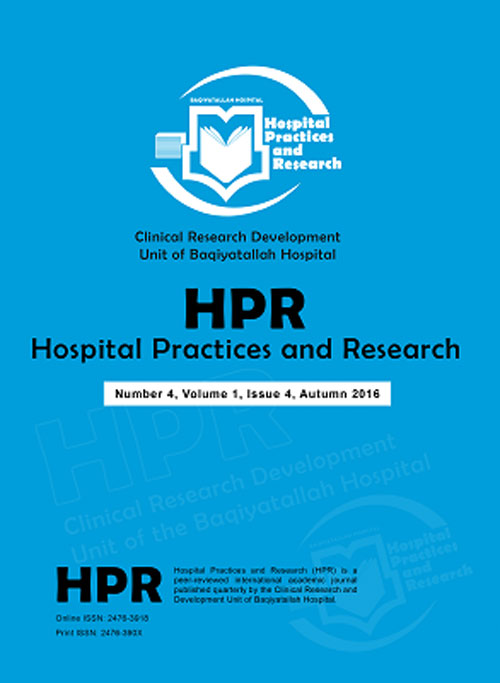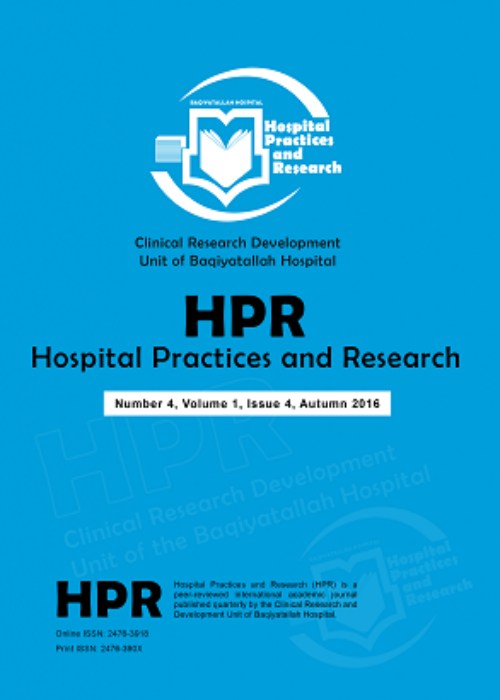فهرست مطالب

Hospital Practices and Research
Volume:1 Issue: 4, Autumn 2016
- تاریخ انتشار: 1395/08/29
- تعداد عناوین: 7
-
Pages 105-113BackgroundIn 2012, Switzerland changed from retrospective to prospective hospital payment based on diagnosis related groups (DRGs), following the example of the United States, Australia, and Germany. As in these countries, the objective of this transition was to motivate hospitals to improve efficiency by making them bear financial risk to some extent.ObjectiveThis contribution seeks to find out whether SwissDRG, the Swiss version of DRG payment, indeed provides hospitals with appropriate incentives, thus creating a level playing field enabling workable competition between them.MethodsThree conditions for creating a level playing are stated, of which the first is tested using data on some 757 000 patient cases treated by 93 hospitals in the year 2012.ResultsThe evidence suggests that hospital payment as currently devised by SwissDRG fails to create a level playing field. Differences in margins over cost of treatment can be traced to a hospital’s portfolio of specialties and mix of patients, both of which are largely beyond their control. The findings of this paper are subject to several limitations. The true DRG-specific cost distributions (and hence expected values) are not known; moreover, emphasis has been on variable cost, neglecting fixed (capital user) cost. Finally, hospitals with a high amount of capital user cost may well benefit from modern technology contributing to their efficiency in terms of variable cost.ConclusionThe finding that current hospital financing by SwissDRG fails to create a level playing field is likely to be robust, calling for an expeditious adjustment be-cause hospitals are exposed to financial risk to a greatly differing degree. It may be appropriate for them to purchase insurance against their financial risk, which is largely driven by influences beyond their control.Keywords: Hospital financing, DRG payment, Cost efficiency, Financial risk, Incentive problems
-
Pages 114-120BackgroundBusiness process management systems (BPM) can automate all processes in an organization. These systems provide the possibility of identifying, modeling, deploying, implementing, function managing, integrating with other information systems, monitoring and improving an organization's business processes in a standard form. As far as the authors know, no related research has been performed in this field.ObjectiveThis study investigated the feasibility of establishing business process management in hospitals in Iran.MethodsThis qualitative research involved 13 participants selected by purposive sampling, including faculty members from medical universities and managers of hospitals. Data was collected through semi-structured interviews and analyzed using qualitative content analysis.ResultsInterviewees were asked about the requirements for establishing BPM. To more easily understand the content, the interveiwees’ responses were classified into two general categories: prerequisites for guidelines and procedures, and prerequisites for electronic healthcare records.ConclusionDespite slight differences between the two groups of respondents (healthcare administrative experts and medical informatics management experts), there was a consensus among the experts about the effectiveness and efficiency of using BPM in healthcare organizations. Furthermore, respondents maintained that, even though numerous prerequisites would be needed for the establishment of this kind of processing reform given the current situation in Iran, some benefit could be gained from implementing to any extent possible this approach in Iran’s hospitals.Keywords: Business process management, Process improvement, Healthcare organizations
-
Pages 121-128BackgroundPatients with schizophrenia can experience a deteriorated performance in many of the skills needed in daily life, the workplace, the family circle, or in social interactions.ObjectiveThis definitive study used comparison to evaluate the functionality, treatment compliance to therapy, and styles of coping with stress of schizophrenic patients who work and are members of an association.MethodsThe individuals participating in this study were divided into four groups. Group 1 were members of an association and employed; Group 2 were members of an association and unemployed; Group 3 comprised non-members who were employed; and group 4 were non-members and unemployed. A total of 60 patients (15 in each group) comprised the sample. Data was collected by means of the Individual Information Form, the Adaptation Rate Scale for Medical Therapy, the Functional Recovery Scale in Schizophrenia Patients, and the Scale for Coping with Stress. Statistical analyses and interpretations were conducted using frequency and percentage, t test, and analysis of variance (ANOVA) to assess the data.ResultsIt was observed that being a member of an association and working at a job affected the social and occupational functionalities in schizophrenia patients participating in the study, but the styles of therapy adaptation and coping with stress did not affect these areas.ConclusionResults indicated that the use of current antipsychotic drugs did not affect functional areas, therapy adaptation, or styles of coping with stress.Keywords: Schizophrenia, Functional behavior, psychology, Therapeutics, Psychological, Commerce
-
Pages 129-134BackgroundThe implementation of patient education within a hospital is a difficult task that plays a key role in improving and controlling diseases and providing quality healthcare services.ObjectiveThe current study evaluated the effect of patient education on the quality of nursing care and inpatient satisfaction in surgical wards of selected hospitals in Isfahan, Iran.MethodsThis quasi-experimental study was conducted in 2014. The sample group consisted of 64 patients admitted to the surgical wards of select hospitals in Isfahan and selected using the voluntary sampling method. Participants were randomly divided into experimental (n=32) and control (n=32) groups. A patient education program was implemented for each subject in the experimental group (during hospitalization and after discharge), but no intervention was conducted for the control group. Data was collected from both groups before and after the educational intervention using the standard questionnaire SERVQUAL to measure expectations (with a reliability of 87%), perceptions (with a reliability of 85%), and inpatient satisfaction (with a reliability of 83%). Data was analyzed using descriptive statistics, univariate and multivariate analysis of covariance, Kolmogorov-Smirnov, Chi-square, and t-tests in SPSS software (ver. 20).ResultsThe results of covariance analysis showed that the patient education program significantly increased the mean scores of the quality of nursing services and inpatient satisfaction in the experimental group compared with the control group (p<0.01).ConclusionA patient education program is an important pillar for improving public health. It is also a low-cost intervention to increase a patient's hope in living a good quality life.Keywords: Patient education, Quality of nursing care, Patient satisfaction, Surgical wards
-
Pages 135-140BackgroundOne way to improve the performance of hospitals, the largest resource-consuming units in the healthcare sector, is to continuously evaluate their performance.ObjectiveThe current study assessed the performance of hospitals affiliated with the Kurdistan University of Medical Sciences using data envelopment analysis (DEA).MethodsThis retrospective descriptive-analytic study used DEA to assess efficiency types (technical, managerial, and scale) in hospitals of the Kurdistan University of Medical Sciences (n = 12) in the years 2007 to 2011. The number of active beds, nurses, physicians (general and specialist), and other staff were inputs; inpatient admission and occupied bed days were outputs. Stata version 12 was used for data analysis.ResultsThe mean technical, scale, and managerial efficiency values were 0.85, 0.89, and 0.95, respectively. The highest and lowest slack inputs were nurses and active beds, respectively.ConclusionThe findings indicate that Kurdistan hospitals were less than appropriately efficient during the studied period. They also suggest that there is a capacity of about 15% for enhancing output in hospitals (compared with the most efficient studied hospitals) without increasing costs or inputs.Keywords: Data envelopment analysis, Efficiency, Hospitals performance
-
Pages 141-145BackgroundDrugs play a strategic role as a health commodity. Thus, the supply chain management of drugs is an important issue to reducing costs and thereby improving patient health.ObjectiveThis study evaluated the status of drug supply chain management and health reform in the pharmaceutical sector of teaching hospitals in Ahvaz, Iran.MethodsThis cross-sectional study was carried out in pharmacies of teaching hospitals in Ahwaz, Iran in 2015. Data was collected through a checklist extracted from the Evaluation Checklist of the Food and Drug Deputy and related articles. The study checklist examined six dimensions of the Evaluation Checklist, including drug storage, administrative regulations, preparation of medicines, drug distribution, taking medication, and implementation of health reforms in the pharmaceutical sector. The content validity of the checklist was confirmed by experts and pharmaceutical specialists. Data was analyzed for descriptive characteristics such as frequency and percentage using EXCEL version 2010 software.ResultsThe findings show that hospitals met standards for administrative regulations with 78.5% and preparation of medicines with 77.25%. The dimensions of drug storage with 74.75%, taking medication with 74.25%, implementation of health reforms with 71.5%, and drug distribution with 62.5% were in a near-standard state.ConclusionSupply chain management systems of medicines in teaching hospitals are near-standard. To improve hospitals, offering proper training to employees, using the fixed-rate shopping system, and providing facilities to patients are recommended.Keywords: Hospital, Pharmacy, Drug chain management, Health reform
-
Page 146International experience has shown that the increasing diversity in healthcare services precludes the integration of all services under a government health insurance plan in terms of performance and economy; no institution receiving a fixed amount of money per capita is able to provide all services. Supplementary insurance is used in many countries (1). In Iran, comprehensive coverage of medical costs through a basic government medical insurance program is not possible because of the rising costs of diagnosis, use of more up-to-date and expensive medical technologies, and the development of new treatment methods. The number of people deprived of the right to healthcare is increasing daily. The structure of complementary insurance is based on participation and provides three types of coverage: completion of services, completion of costs, and integration of costs and services. In many leading countries, insurance is provided to a group with the participation of the insured and the insured’s employer who pays the employee's premiums. In some cases, the premium is paid entirely by the insured, and governments generally have the participation priority in paying the premium. In countries around the world, the private sector has been effective in enriching complementary insurance, but careful monitoring by the state is emphasized. Studies have shown that considering the deductible for covered services is useful for creating competition among insurance institutions so as to control consumption patterns and avoid unnecessary demands (2-4). Considering Article 29 of Iran’s Constitution which reads, "covering all medical services the non-provision of which puts one's health at risk" and examining the structure and performance of the Healthcare Insurance Organization, it seems that, despite growth in the covered population, complementary coverage is not proportionate to the current organizational structure. Therefore, the structure needs to be modified to adapt to new circumstances. In general, the successful implementation of complementary insurance programs in the European Union, especially in France that has one of the most successful insurance systems in the world, shows that principles should be established to govern the healthcare systems available in the market. Furthermore, requiring participation in health insurance should be based upon a person’s income, while care should be provided based on medical need, not financial participation (5).


